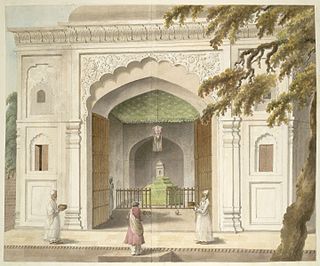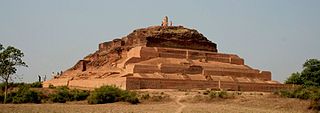Related Research Articles

Rohilkhand is a region in the northwestern part of Uttar Pradesh, India, that is centered on the Bareilly and Moradabad divisions. It is part of the upper Ganges Plain, and is named after the Rohilla tribe of Pathans. The region was called Madhyadesh and Panchala in the Sanskrit epics Mahabharata and Ramayana. During the colonial era in India, the region was governed by the Royal House of Rampur.

The Bangash, Bungish, Bangaš or Bangakh are a tribe of Pashtuns, inhabiting their traditional homeland, the Bangash district which stretches from Kohat to Tall in Hangu and Spīn Ghar, Kurram in Khyber Pakhtunkhwa, Pakistan. They also live as a smaller population in Dera Ismail Khel, Bannu while also a smaller population of Bangash inhabit Gardez, Paktia, Afghanistan.

Nawab Muhammad Amir Khan (1769–1834) was a military general in the service of Yashwantrao Holkar of the Maratha Empire and later became the first ruler of the princely state of Tonk. Amir Khan was a Hindustani Pathan and a North Indian Muslim. Born and bred in Sambhal, Amir Khan was the son of a Zamindar in Uttar Pradesh, Hayat Khan, while his grandfather Taleh Khan was a Pashtun from the Salarzai tribe of District Buner in modern-day Pakistan who had migrated to and acquired land in Rohilkhand.

Rohillas are a mixed Indian community of Pashtun heritage, historically found in Rohilkhand, a region in the state of Uttar Pradesh, India. It forms the largest Pashtun diaspora community in India, and has given its name to the Rohilkhand region. The Rohilla military chiefs settled in this region of northern India in the 1720s, the first of whom was Ali Mohammed Khan.

The Bareilly district belongs to the state Uttar Pradesh in northern India. Its capital is Bareilly city and it is divided in six administrative division or tehsils: Aonla, Baheri, Bareilly city, Faridpur, Mirganj, and Nawabganj. The Bareilly district is a part of the Bareilly Division and occupies an area of 4120 km2 with a population of 4,448,359 people according to the census of 2011.
Pashtun diaspora comprises all ethnic Pashtuns. There are millions of Pashtuns who are living outside of their traditional homeland of Pashtunistan, a historic region that is today situated over parts of Afghanistan and Pakistan. While the (erstwhile) Pashtunistan is home to the majority of Pashtun people, there are significant local Pashtun diaspora communities scattered across the neighbouring Pakistani provinces of Sindh and Punjab, particularly in their respective provincial capital cities of Karachi and Lahore. Additionally, people with Pashtun ancestry are also found across India; particularly in Rohilkhand, a region in the Indian state of Uttar Pradesh; and in the Indian states of Gujarat and Rajasthan. Outside of South Asia, significant Pashtun diaspora communities are found in the Arab states of the Persian Gulf, the United States, the United Kingdom, Germany, Iran, Australia, Canada, and Russia.
The Pathans of Punjab, also called Punjabi Pathans or Pathans, are descendants of Pashtun settlers, an Eastern Iranian ethnic group, in the Punjab region of Pakistan and India. They were originally from the Pashtunistan region of Afghanistan and Pakistan bordering the Punjab region. Most of these Pashtun communities are scattered throughout the Punjab and have over time assimilated and integrated into the Punjabi society and culture.
The Kakori Shaikh are a Muslim community found in the state of Uttar Pradesh in India. They are also found in the province of Sindh in Pakistan, particularly the city of Karachi.
The demographics of Uttar Pradesh is a complex topic, which is undergoing dynamic change. Uttar Pradesh is India's most populous state, and the largest subdivision in the world. It has a population of about 199,812,341 as per the 2011 census. If it were a separate country, Uttar Pradesh would be the world's fifth most populous nation, next only to China, the rest of India, the United States of America and Indonesia. Uttar Pradesh has a population more than that of Pakistan. There is an average population density of 828 persons per km2 i.e. 2,146 per sq mi. The capital of Uttar Pradesh is Lucknow, and Prayagraj serves as the state’s judicial capital. Hindus and Muslims both consider the state as a holy place.

Tailoring is the English translation of Darzi. In India, The art and culture of stitched clothes came to India from West Asia. In India, there was a practice of wrapping clothes instead of stitched clothes, an example of which you can see in ancient Indian paintings, in which kings, maharajas and women all used wrapped clothes. In the Indian tradition, it was customary to wrap clothing over the body rather than wear stitched cloth. The word Darzi comes from the west Asia Persian language. In Hindi Darzi is pronounced Darji.

GujaratiPathans are a group of Pashtuns, who are settled in the region of Gujarat in western India. They now form a distinct community of Gujarati and Urdu/Hindi speaking Muslims. They mainly speak Urdu/Hindi with many Pashto loanwords, but most of them have been Indianized so some may have Gujarati as their first language as well, few elders in the community still speak Pashto. Common tribes include Turk pathan, Babi or Babai, Niazi, Khan, Bangash, Durrani, and Yousafzai.

Islam in Uttar Pradesh is the second largest religion in the state with 38,483,967 adherents in 2011, forming 19.26% of the total population. Muslims of Uttar Pradesh have also been referred to as Hindustani Musalman. They do not form a unified ethnic community, but are differentiated by sectarian and Baradari divisions, as well as by language and geography. Nevertheless, the community shares some unifying cultural factors. Uttar Pradesh has more Muslims than any Muslim-majority country in the world except Indonesia, Pakistan, Bangladesh, Nigeria, Egypt, Iran and Turkey.

Western Uttar Pradesh is a region in India that comprises the western districts of Uttar Pradesh state, including the areas of Rohilkhand and those where Hindi and Braj are spoken. The region has some demographic, economic and cultural patterns that are distinct from other parts of Uttar Pradesh, and more closely resemble those of Haryana and Rajasthan states. The largest city of the region is Ghaziabad, while the second-largest city, Agra, is a major tourist destination.

According to the epic Mahābhārata, Bareilly region (Panchala) is said to be the birthplace of Draupadi, who was also referred to as 'Panchali' by Kṛṣṇā. When Yudhishthira becomes the king of Hastinapura at the end of the Mahābhārata, Draupadi becomes his queen. The folklore says that Gautama Buddha had once visited the ancient fortress city of Ahicchattra in Bareilly. The Jain Tirthankara Parshva is said to have attained Kaivalya at Ahichhatra.

The Pathans of Madhya Pradesh are an Urdu-speaking Pashtun community settled in the present-day Indian state of Madhya Pradesh as well as a small minority of internal migrants and their descendants in neighbouring Chhattisgarh state, which was partitioned in 2000.
Ghori, are a Pashtun subtribe of the larger Ghoryakhel tribe. Their descendants are known as Ghori pathans within the Indian subcontinent.
Pathans in India or simply known as Pathans are citizens or residents of India who are of ethnic Pashtun ancestry. "Pathan" is the local Hindavi term for an individual who belongs to the Pashtun ethnic group, or descends from it. The term additionally finds mention among Western sources, mainly in the colonial-era literature of British India. Historically, the term "Afghan" was also synonymous with the Pathans. The Pathans originate from the Eastern Afghanistan and Northwestern Pakistan regions, ethnolinguistically known as Pashtunistan.

Native speakers of Urdu are spread across South Asia. The vast majority of them are Muslims of the Hindi–Urdu Belt of northern India, followed by the Deccani people of the Deccan plateau in south-central India, the Muhajir people of Pakistan, Muslims in the Terai of Nepal, and the Biharis and Dhakaiyas of Old Dhaka in Bangladesh. The historical centres of Urdu speakers include Delhi and Lucknow, as well as the Deccan, and in the modern era, Karachi. Another defunct variety of the language was historically spoken in Lahore for centuries before the name "Urdu" first began to appear. However, little is known about this defunct Lahori variety as it has not been spoken for centuries.

Dargah Bade Purush Baba Dikauli Sharif or Bade Purush Dargah is a Dargah (shrine) located at Dikauli village in Shravasti district of Uttar Pradesh, near Bahraich. It is the dargah of Hazrat Ameer Nasrullah or Nasrullah Shah or Hazrat Saiyyad Nasrullah Gaazi or Mir Nasrullah, who is famously known as Bade Purush or Bade Purukh and Budhwa Baba. Bade Purush is revered by both the Muslims and Hindus.
References
- ↑ Amir Hasan, Anthropological Survey of India, Baqr Raza Rizvi, J. C. Das, K. S. Singh (27 February 2019). People of India: The Communities: Nai-Yadav. Bio-Anthropological Indormation. Glossary. Select Bibliography. Maps. Index. Anthropological Survey of India. ISBN 9788173041143.
{{cite book}}: CS1 maint: multiple names: authors list (link) - ↑ Shaji, U. S. (2010). Religions of IndiaA Multidimentional Study. Cyber Tech Publications. p. 36. ISBN 9788178845340.
A well known Indian Muslim community is Pathan
- ↑ Amir Hasan (2005). People of India: The Communities: Nai-Yadav. Bio-Anthropological Indormation. Glossary. Select Bibliography. Maps. Index. Anthropological Survey of India. p. 1139. ISBN 9788173041143.
- ↑ Bengal, Past & Present:Journal of the Calcutta Historical Society · Volume 86. Calcutta Historical Society. 1967. p. 47.